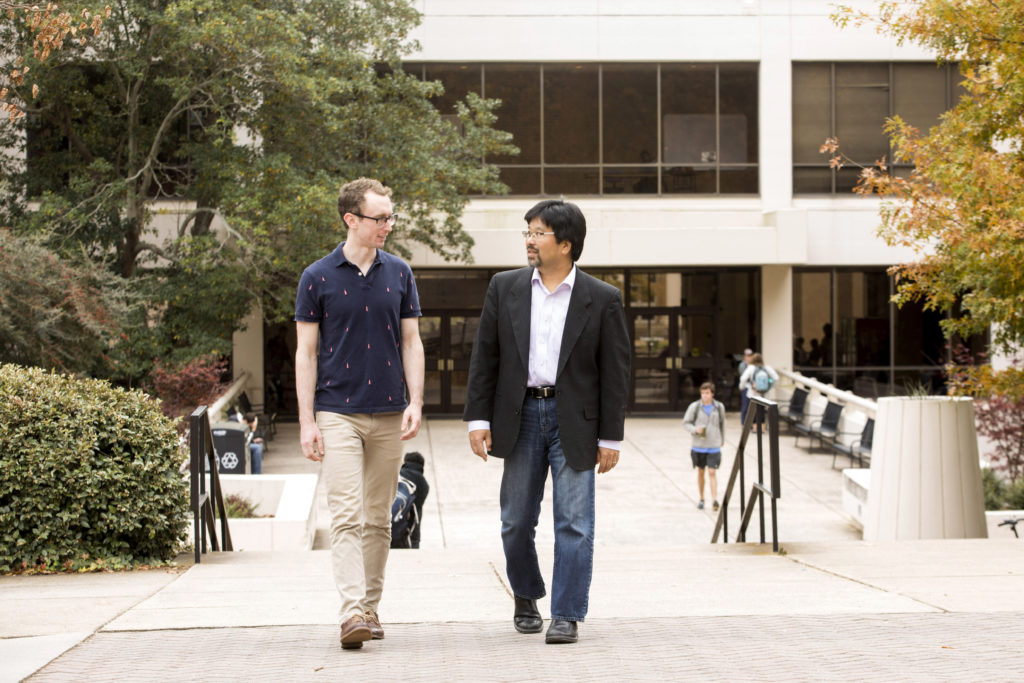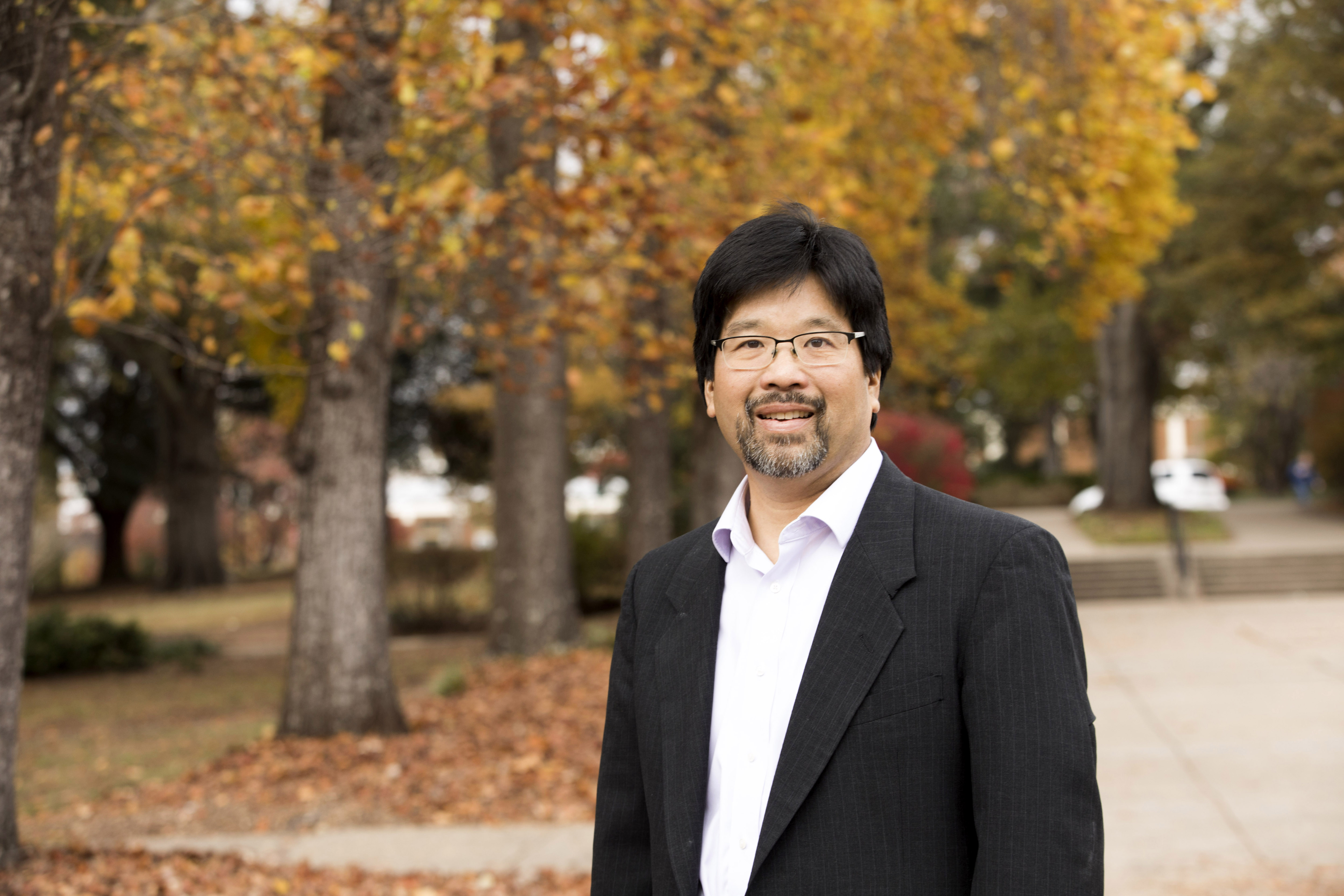Daniel Nakano, a Distinguished Research Professor of mathematics in the Franklin College of Arts and Sciences, integrates research, teaching and professional training for students through innovative, small-group mentoring.
Where did you earn degrees and what are your current responsibilities at UGA?
I earned my bachelor’s degree in mathematics from the University of California, Berkeley in 1986 and my Ph.D. at Yale University in 1990.
I’m currently a Distinguished Research Professor in the department of mathematics, which is part of the Franklin College of Arts and Sciences. My primary departmental duties include conducting mathematical research, presenting my work outside of UGA, advising Ph.D. students, mentoring postdoctoral fellows and teaching graduate and undergraduate courses. I’m also actively involved with serving on college and university committees.
When did you come to UGA and what brought you here?
My first tenure-track job was at Utah State University, and I spent six years there before coming to UGA in 2001. I was attracted to UGA by the presence of a strong research group in algebra and with the mathematics department’s commitment to its Ph.D. and postdoctoral programs.
My family and I were impressed by the quality of life in Athens. The location has been ideal for us to take advantage of the many opportunities afforded by living in the eastern part of the U.S.
What are your favorite courses and why?
My favorite undergraduate course to teach is linear algebra. Over the years, I have found this can be a challenging course for both students and instructors. The subject is a mix of elegant mathematical theory with concrete algebraic formalism involving vectors and matrices. It is easy to overwhelm students with the theoretical side of the subject. In teaching the course, I emphasize computational techniques first to help students build their confidence with the language and the machinery. This approach makes the transition easier for students when the theory is presented.
At the graduate level, I enjoy teaching courses in algebra and representation theory. Representation theory is a rich subject that emerged over 100 years ago and is used to investigate complicated algebraic structures via linear algebra.
What are some highlights of your career at UGA?
I was honored to be the recipient of three research awards at UGA—the Creative Research Medal (2007), Distinguished Research Professor (2010) and the Lamar Dodd Creative Research Award (2016). In 2012, I was in the inaugural class of the Fellows of the American Mathematical Society. These honors are a testament to the support I have received from mentors, colleagues, collaborators, friends and family members over the years.
From 2008-2015, I was the principal investigator and the director of the University of Georgia VIGRE Program. The central goal of the NSF-funded VIGRE program was to integrate research and education in the mathematical training of postdoctoral fellows, graduate students and undergraduates. In 2011, I was ranked as the 19th highest NSF-funded mathematician in the United States.

How do you describe the scope and impact of your research or scholarship to people outside of your field?
Representation theory has emerged as a central area of modern mathematics with connections to combinatorics, algebraic geometry, topology and number theory, along with applications to chemistry and physics. Representations are mappings, regarded as snapshots, of complicated algebraic objects (such as groups and Lie algebras) to an array of numbers (matrices). These realizations by matrices encode local data that can yield deep insights into these complicated algebraic objects.
Recent developments have included using the representation theory of Lie groups to better understand signal processing and the translation of the P versus NP problem in computer science via geometric complexity theory into questions about decomposing representations for the general linear group.
My research is at the interface between representation theory, geometry and homological algebra. Collecting all the representations for a certain algebraic object forms a tensor triangulated category. Methods from homological algebra can be used to build a bridge between tensor triangulated categories and geometric objects. Uncovering this “hidden geometry” often leads to new insights about the algebraic object and its representations.
How does your research or scholarship inspire your teaching, and vice versa?
Over the past 20 years, I have put a lot of thought into developing effective models for the integration of research, teaching and professional training. One of the keys has been to create environments that promote effective mentoring.
I have been using a small-group research model through three-person teams. These teams consist of the Ph.D. advisor, a postdoc and a graduate student. This model encourages the development of cooperative working relationships between the student, postdoc and advisor. This past year, I have been experimenting with the use of undergraduate research internships where advanced undergraduates who have had ample preparation with graduate-level mathematics courses work with senior-level mathematicians on their research projects. Mentorship is provided for the undergraduates with their graduate school applications.
What do you hope students gain from their classroom experience with you?
I have found that many of today’s students suffer from “math anxiety,” and I believe that much of this has to do with exposure to unsound teaching practices and the use of technology in the classroom.
In order for my students to gain confidence in their abilities, I assign only written homework where the students have to write out their answers carefully and provide logical explanations. If I’m not provided a grader for a course, I have been known to hand grade up to 3,000 homework problems in a semester.
Overall, my courses highly emphasize writing and reasoning skills. My hope is this experience will not only prepare my students for transitioning into higher-level mathematics courses, but also be applicable for problem solving in other aspects of their lives.
Describe your ideal student.
The ideal student is one who demonstrates outstanding intellectual drive and curiosity. The student is not afraid to explore beyond the walls of the classroom and is self-motivated to independently learn on their own.
Favorite place to be/thing to do on campus is…
My wife, RuthElizabeth, and I enjoy attending concerts and plays on campus at the Hodgson School of Music and the Fine Arts Building. It is amazing that the location and quality of the facilities at UGA offers our family the opportunity to see musicians and ensembles such as the Emerson String Quartet, Tokyo String Quartet, Midori, Jake Shimabukuro and Yo-Yo Ma only five minutes from our house.
Our daughters, Susanna and Aneesa, played high school golf at Clarke Central. They practiced regularly at the UGA golf facility. We have many fond memories playing golf at the UGA golf course as a family and in the annual Lukas’ Fund Golf Tournament.
Beyond the UGA campus, I like to…
When I have time, I enjoy playing golf, reading and listening to music. I grew up playing classical and jazz music and continue to listen to various artists in this genre. Recently, I have expanded my horizons by examining music from Asia and Latin America.
For my own professional development as an educator, I embrace opportunities to learn a new subject or skill starting as a novice. At Utah State (at the age of 32), I learned to ski by taking lessons through the university. I became a first-time dog owner at the age of 46. This past year, I have started a quest to gain insight and knowledge about 19th- and 20th-century Japanese art.

Community/civic involvement includes…
I have been involved in helping politicians at the local and state level with their campaigns by canvasing door to door. Once a month, my wife and I are involved with delivering meals for people who are in need of housing through the Interfaith Hospitality Network.
Favorite book/movie (and why)?
It is hard for me to select one book, but I can list some of my favorites.
I enjoy reading books that dissect the interactions between process and decision making. Some of the classics are “The Millionaire Next Door” and “Good to Great.”
More recent reading has included “Battle Hymn of the Tiger Mother,” “Outliers” and “Moneyball.” Other books that I like that explore race relations and politics are “Farewell to Manzanar,” “Roots,” “The Autobiography of Malcolm X” and “Game Change.”
The one UGA experience I will always remember will be…
In 2015-2016, I served as the Faculty Senate president for the Franklin College of Arts and Sciences. That year, I learned quite a bit about the power of faculty governance and the need for effective communication between administrators and the faculty.
In the fall, there were serious issues about the new evaluation process instituted by the Provost’s Office that were brought to the Senate floor. A letter was crafted from the Senate to the dean expressing our concerns. Subsequently, the dean provided a clear response on how he would interpret the guidelines. At the end of the academic year, the Senate needed to mobilize quickly to write a strong response in opposition to HB 859 (Campus Carry). Our letter was faxed to the governor’s office and that year HB 859 was vetoed. The Senate’s actions made the news in the Athens Banner-Herald on both occasions.
Is there anything else you’d like to add?
I grew up in Kirkland, Washington (home of the first Costco). Growing up in the Seattle area provided me with the opportunity to be involved in the Japanese-American community.
I was enlightened by many stories about the serious hardships people endured during WWII. My father, who was an atomic bomb survivor, and mother lived in Japan during that time. Other friends and family members had everything taken away from them and were sent by the U.S. government to be incarcerated at internment camps. Some later served in the heroic 442nd Infantry Regiment. The wisdom and insights that were passed down to me have profoundly shaped my views on racial discrimination and injustice in our society.


